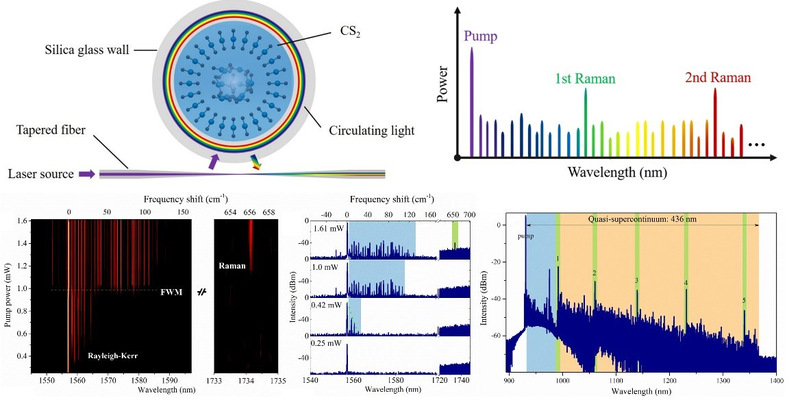With the solid high quality (Q) factor and small mode volume, whispering-gallery mode microcavities are demonstrated as an excellent experimental platform for studying nonlinear optics and new micro photonic devices, which can provide strong enhancement to light–matter interactions. However, most previous studies were restricted to solid state microcavities. Compared to solid materials, liquid materials have 2-3 times higher nonlinear coefficient, and liquid anisotropic molecule is unique for abundant vibrational and rotational degrees of freedom. Accordingly, liquid materials have great potential in functional photonic devices and exploring the new physics.
Though liquid materials are seen as strong attraction in microcavity photonics, the instability of micro-formed microcavity by liquid drop impedes the practical application of liquid materials, so they have not been studied much. In this research, the gap is bridged by filling an optofluidic microbubble resonator with carbon disulfide, and the related anisotropic molecular cavity optomechanics effects are investigated. Due to the enhanced coupling between the optical mode and the rotation/vibration of molecules, stimulated Rayleigh–Kerr/Raman–Kerr scattering effects are observed. Molecular cavity optomechanics provides a broadband gain for generating Stokes photons in high-Q optical modes, and eventually allows quasi-supercontinuum generation with a bandwidth of 436 nm under a low continuous laser pump power of about 10 mW. This work opens a new avenue for strong light–matter interactions by exploring rotational and vibrational molecular cavity optomechanics, which provides a promising platform for nonlinear optics, cavity-enhanced molecular reorientation dynamics, and novel optical sources.
The research, entitled “Optical Supercontinuum Generation via Rotational and Vibrational Molecular Cavity Optomechanics”, was published in the international journal, Laser & Photonics Review. Lu Qijing, Professor in FNU, is the first author of this paper with Xie Shusen, Professor in FNU and Zou Changling, Professor in the College of Physics of University of Science and Technology of China as the joint corresponding authors. This research is supported by the National Key Research and Development Program of China, the National Natural Science Foundation of China and Special Central Funds for Guiding Local Scientific and Technological Development .

(Translated by Bai Yunfei/Reviewed by Chenfang)
